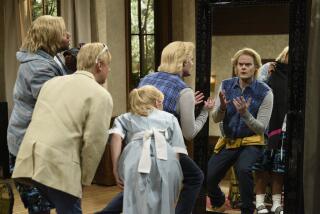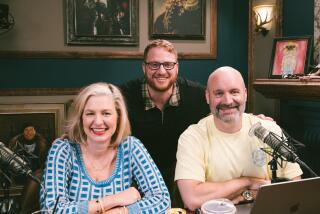Staying Tuned : Radio’s Faithful Fans Like the Mike Better Than the Tube
- Share via
A shot rings out.
Then, as the high-pitched squeal of a ricocheting bullet fades, announcer Jay Michael excitedly intones:
“Now, as gunshots echo across the wind-swept reaches of the wild Northwest, Quaker Puffed Wheat (sound of gunshot) and Quaker Puffed Rice (gunshot), the breakfast cereal shot from guns (two gunshots) present the challenge of the Yukon (a dog barks). It’s Yukon King, sweetest and strongest lead dog of the Northwest blazing the trail for Sgt. Preston of the Northwest Mounted Police, in his relentless pursuit of lawbreakers (Deep voice of Sgt. Preston: ‘On King! On you huskies!’) (dogs bark)). ...”
So begins “The Call of Duty,” episode No. 579 of “Sgt. Preston of the Yukon” starring Paul Sutton as the famed, square-jawed Canadian Mountie. Air date: Oct. 31, 1948.
“ ‘Sgt. Preston’ was one of my favorite shows when I was a kid,” said Clyde Benge, 46, switching off the reel-to-reel tape recorder in the spare bedroom of his Huntington Beach condominium.
As a boy growing up in Huntington Beach during the late ‘40s and early ‘50s, Benge recalled, he had a complete Sgt. Preston town built from cardboard cut-outs from the backs of cereal boxes.
Benge, a former banker who now is a collection manager for Chrysler Corp., hasn’t seen his Sgt. Preston town since Harry Truman was in office. But he still has his Sgt. Preston “square-inch land deal” certificate, the youthful bearers of which supposedly owned one square inch of land in the Yukon.
Over the years, Benge has more than made up for his other long-lost radio premiums: He’s now the proud owner of not only a Sgt. Preston gold ore detector, but a Sgt. Preston pedometer, signal flashlight, mounted police whistle and totem pole collection (“all five of them”).
The Preston items are only a sampling of the flotsam and jetsam of radio’s golden age that have wound up in Benge’s possession.
His spare bedroom is a treasure trove: tapes of the old shows, radio premiums, several hundred books about radio, posters and Depression-era radios. (His most valuable radio premiums--such as his collection of decoder rings and a rare, 1943 “Bulldog Drummond” bombsight--are kept in safe deposit boxes.)
Closing the sliding door of his closet, which is lined with tapes of more than 30,000 old radio shows, the low-key collector said matter-of-factly: “It’s crazy. You get hooked.”
Benge is not the only one hooked on those halcyon days--and nights--when the airwaves were ruled by such broadcasting immortals as Jack Benny (“Now cut that out!”), the Whistler (“I know many things, for I walk by night.”) and the Aldrich Family (“Hen-reee! Henry Aldrich!” “Coming, Mother!”)
Benge is one of 1,330 members of the Society to Preserve and Encourage Radio Drama, Variety and Comedy. That’s SPERDVAC, for short.
The Southern California-based, nonprofit organization was formed in 1974 in the wake of a wave of nostalgia for old-time radio.
Through its tape-lending library, SPERDVAC satisfies members’ yearnings to relive those “thrilling days of yesteryear,” a time when thundering hoofbeats were actually a team of sound effects men pounding halves of coconut shells on gravel.
“We’ve got just about every show you could name: ‘Jack Benny,’ ‘The Shadow,’ ‘Lux Radio Theater,’ ‘Suspense,’ ‘Inner Sanctum’ . . . ,” said acquisitions chairman John Gassman, 33, of Whittier, whose twin brother Larry is president.
The Gassmans are two of the earliest members of the organization, which meets once a month either in Encino, Buena Park or Thousand Oaks. The next meeting, on Sept. 17, will be held in the Buena Park Public Library. The public is invited to hear guest speaker Jean Carson from Palm Springs.
And who, as moderator Clifton Fadiman might ask the experts on “Information Please,” is Jean Carson?
“She did a lot of radio in New York in the late ‘40s and ‘50s,” Larry Gassman explained. “She had an incredibly deep voice that allowed her to play a lot of voluptuous trollops on ‘Gunsmoke’ and ‘Frontier Gentleman.’ ”
Over the years, SPERDVAC has played host to dozens of guest speakers from the old radio days, including humorist Stan Freeberg, announcer George Fenneman, renowned radio writer-director Norman Corwin and Carlton E. Morris, creator and writer of “I Love a Mystery” and “One Man’s Family.”
That’s not to mention Jim Jordan, better known as Fibber of “Fibber McGee and Molly,” those well-known residents of 79 Wistful Vista who had the most famous cluttered closet in America. Notes Larry Gassman: “His line was, ‘Gotta straighten out that closet one of these days.’ ” (Actually, according to one club member’s calculations, the closet gag was featured in only 128 of the 1,550 “Fibber McGee and Molly” shows.)
When it comes to radio, SPERDVAC members are prone to such attention to detail. Larry Gassman, for example, can instantly cite the date that Ozzie and Harriet Nelson, then known as “America’s favorite young couple,” made a brief guest appearance on “The Jack Benny Program” to plug their radio show: 3/27/49.
Another important date for radio buffs is Nov. 11. That’s when SPERDVAC will kick off its Annual Old Time Radio Convention at the Viscount Hotel in Los Angeles. More than 500 people are expected to turn out for two days of workshops and panel discussions on their favorite subject.
The convention’s theme is “A Salute to CBS Radio,” and the highlight will be the re-creation of two popular radio programs, complete with sound effects, taped musical accompaniment and as many of the original performers as are available: “Gunsmoke,” with actor Parley Baer re-creating his role as Chester, and a radio play, “The Undecided Molecule,” to be directed by its writer, Norman Corwin.
“People will get a chance to see what ‘good’ radio was,” said John Gassman. “We have the original people re-creating the shows, and that in itself is special. Just the visual performance of people reading around a microphone with a script in their hand is totally different than the pictures perceived when you’re listening to the radio, so you get an audio and a visual impression.”
The Gassmans, both of whom are blind, volunteer countless hours for the club. They man the SPERDVAC telephone line, (213) 947-9800, answering questions about club activities and occasionally serving as reference or referral service for researchers with questions about old-time radio programs and personalities. (Vincent Price once called to donate his collection of radio transcription disks).
SPERDVAC is always on the lookout for the old disks--16-inch recordings made of live broadcasts.
The organization’s collection of about 15,000 disks, some dating back to 1929, is stored in a former bank building in Whittier. All the disks have been transferred onto tape. The disks--glass or aluminum-based vinyl--are extremely fragile and literally flake with age.
“It’s imperative that this material be transferred to tape,” said John Gassman. “If we don’t get them transferred, we lose an awful lot of important history.”
Many of the group’s transcription disks were purchased, some were rescued from being thrown away and others were donated by members, former radio sound engineers and radio personalities. The Cecil B. DeMille estate donated the transcription disks of 240 “Lux Radio Theater” shows, which were hosted by the legendary movie director.
The club’s most recent acquisitions--2,100 “Lone Ranger” transcription disks and more than 900 “Sgt. Prestons”--were donated by their owner, Paladium Entertainment.
As one of the group’s archivists, Benge is in charge of transferring the disks onto tape. Before he’s through, he figures he will have listened to more than 450 hours worth of the 15- and 30-minute episodes of the program that aired nationally between 1947 and 1955.
Although SPERDVAC boasts many younger members, the vast majority are people like Clyde Benge: They can actually remember when many of the old shows were broadcast live.
Benge denies he’s reliving his youth when he listens to the old programs. But he retains vivid memories of the shows he listened to on the plastic Emerson radio his family kept on the kitchen table.
“Radio allowed you to use your imagination,” he said. “TV does not. So the real enjoyment of radio is the ability to use your imagination. I think the writing for the most part was much more creative than anything on TV today.”
The Gassmans, who conduct an old-time radio show Sunday evenings over KPCC at Pasadena City College, agree.
“I enjoy listening to it for the story content,” said John Gassman. “The sound effects, the acting and the writing all come together to make radio just more consistently fascinating to listen to (than television).”
“Primarily,” said Larry Gassman, “I think the scripts were better in radio and you’re only as good as your script. And those people who were performing were just consummate actors.”
As an actor who spent more than 20 years in radio, Olan Soule appreciates the work that SPERDVAC is doing to keep old-time radio alive.
“They’re real radio buffs there. They know all the old shows and they have furnished me with tapes of many of the shows I did,” said Soule, 79, who lives in Laguna Hills Leisure World with his wife, Norma.
Soule, who has also been in 60 movies, 200 TV shows and 300 commercials, spoke at a SPERDVAC meeting several years ago and is now an honorary member. He enjoys talking to the radio buffs.
“It’s exciting for me--for people from the business back then,” he said, chuckling. “Now they call it ‘old-time radio.’ Then . . . it was our method of making a living. It was a big industry, of course: live radio dramatic shows.”
Soule, who acted in traveling tent shows throughout the Midwest before going into radio in Chicago in 1933, became a regular on one of the most popular soap operas of the ‘30s, “Bachelor’s Children.”
In 1943, he took over as leading man opposite Barbara Luddy on “The First Nighter Program,” one of radio’s earliest dramatic playhouses. The “First Nighter” took listeners to that “little theater off Times Square.” (“Good evening, Mr. First Nighter, the usher will show you to your box. . . .”)
When the show moved from Chicago to Hollywood in 1947, the actor went with it. Soule, who stayed with the program until it went off the air in 1953, said it was his last radio contract.
By the early ‘50s, dramatic radio as it had been known since 1926, when the National Broadcasting Co. first went on the air, was dying.
The death knell was sounded on Sept. 30, 1962, when the last two dramatic shows were canceled by CBS: The theater of the imagination was simply no match for the little brown box that could actually show Bob Hope’s gleaming Pepsodent smile or Jack Benny’s Maxwell in our very own living rooms.
Muses Soule: “You’d be surprised how many people say, ‘I miss radio; I’d like to hear it again and sit there and dress my own characters and build my own sets.’ One reason that radio doesn’t come back is because the sponsors figure it doesn’t have the appeal television has. They figure it doesn’t sell as much. I sometimes wonder about that.”
More to Read
Sign up for The Wild
We’ll help you find the best places to hike, bike and run, as well as the perfect silent spots for meditation and yoga.
You may occasionally receive promotional content from the Los Angeles Times.






